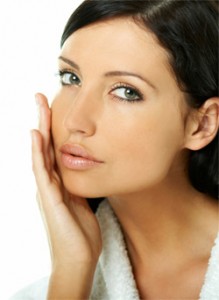Glycolic acid (GA). I'm sure you're familiar with it -- it's everywhere... from at-home treatments to lunch time peels, it's one of those ubiquitous ingredients that has become a mainstay in the skin care industry. But like most of the common, go-to ingredients in the beauty world, the details on what it actually does, how it compares to other ingredients, and how you should use it are muddled... shrouded in conflicting myths, facts, anecdotes.
Thank goodness for Truth in Aging, right?
What it is. Glycolic acid is a member of the α-hydroxy acid (AHA) family, and is one of the most commonly used chemical peeling agents employed to address a wide variety of skin care complaints, including: acne, hyperpigmentation, and fine lines/wrinkles.
In addition to being deeply penetrating, cleansing and exfoliating, topical application of glycolic acid has been shown to be an effective anti-ager: reversing sun damage (such as mottled pigmentation), stimulating collagen & elastin production, quickening cell turnover, increasing skin's thickness, firmness & hydration, and smoothing rough and wrinkled skin.
And although the mechanism of exactly how glycolic acid works to "de-age" the skin is unknown,
several articles and research studies suggest that it is the ability to increase skin renewal (which decreases by 7% every ten years).
Here's how it works: Once applied, glycolic acid reacts with the upper layer of the epidermis, weakening the binding properties of the lipids that hold the dead skin cells together. This allows the outer skin to "dissolve" revealing the underlying skin. To note, the greater the ability to stimulate cell renewal the greater the potential for skin irritation.
So how and where is it used? Well, GA can be found most often as a chemical peel performed by a dermatologist in concentrations of 20%-80% or at-home kits in lower concentrations of 15% or less. One at-home treatment TIA reviewed was Dermaquest's Glyco Creamy Cleanser at a 15% concentration.
Do they work? And at different concentrations? Well, yes: as published in the
Journal of Cosmetic Dermatology, among others, they do. These include: Significant anti-aging benefits for the skin with 70% GA treatments; significant improvement to photodamaged skin with 50% GA treatments; and, successful treatment of superficial scarring and melasma with topical application ranging from ten percent to 30% in 2-week intervals for 16 weeks.
In addition, long-term daily use of low-strength products have been demonstrated clinically and historically to be effective in photodamaged skin, and are recommended for those unable to tolerate peels at higher concentrations.
You've got the wrong idea. There are some ideas out there that GA treatments can cause a number of undesirable effects: photosensitivity, skin dryness, irritation, and dermal thinness. Some of this is true, some of this is not.
Despite what you may have heard about AHA's, they do not cause skin dryness or irritation; rather, as
FutureDerm points out, "it is often the formulation (i.e., the other ingredients) of the AHA treatment that is the source of discomfort, as found in a study by Yu et. al... [With a] second study [pointing out] that transepidermal water loss (TEWL) is not altered by application of AHAs." In fact, as another
study points out, skin hydration in all test groups undergoing various AHA treatments reported modest increases in skin moisturization.
Nor do GA treatments cause the skin to thin -- in fact, it's quite the opposite. As recorded
here, Twenty percent glycolic acid lotion applied twice a day to sun-damaged forearm skin for 3 months increased epidermal thickness, epidermal and dermal hyaluronic acid staining, and collagen gene expression.
What they do do, however, is enhance possible photodamage by ultraviolet light, with even short-term application of 10% glycolic acid sensitizes the skin to the damaging effects of UV light. However,
as one study points out, this photosensitivity is reversed within a week of terminating treatments.





January 12, 2015
by Nicole
I disagree. A close relative of mine is a chemist with a major skin care company and he has told me to stop using AHAs, especially glycolic acid as an exfoliator. His company has use it for decades but will not any longer as the latest research shows it that although it gives short term benefits, long term use will thin the skin and age use fastter
January 29, 2009
by claire
Well, Petra. Most cleansers with Glycolic acid usually suggest leaving the formula on your face for about a minute or more, then washing off. This should be sufficient for the active ingredients to do its work. I would be hesitant applying a lotion onto my face with GA in it that I wouldn't wash off. It just seems to me that it would cause undue irritation. What I like about Dermaquest's creamy glyco cleanser is that it's very much like a lotion, but you still wash it off in the end. If you haven't read my review of it, you can check it out here: http://www.truthinaging.com/2009/01/dermaquest-glyco-creamy-cleanser-15.html
January 28, 2009
by Petra
Thanks for explaining the benefits, I too had heard that glycolic acid would thin the skin, so it's helpful to know that's not true. I'm wondering though, if a serum or lotion with glycolic acid would be more effective than using a cleanser because it stays on the skin longer?